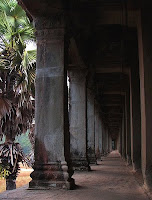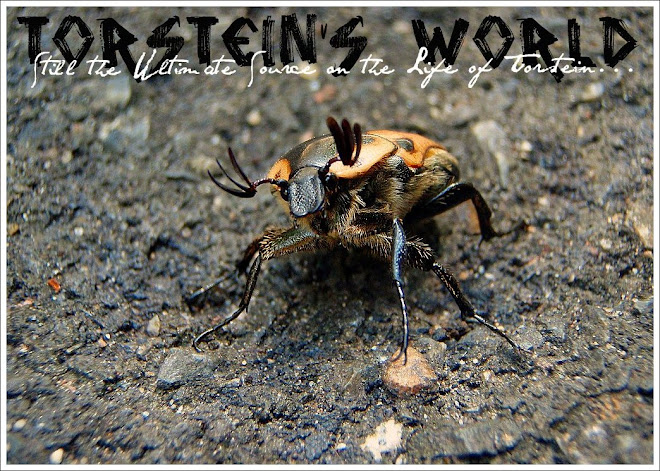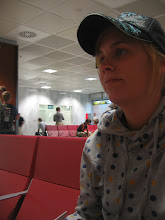Although it's one of the least developed countries in the region, Cambodia was a positive surprise to us, and it immediately joined the Philippines on top of our list of favorite Asian countries. Poverty and developmental problems are much more visible in Cambodia than in its neighboring countries, but the feeling of sincere hospitality and big smilies are also more apparant here. Cambodia is a land of enormous contrasts. One day you'll find yourself walking in the footsteps of the ancient kings of Angkor, taking in the breathtaking architecture and the greatness of the Khmer history. This aspect of Cambodia will fill you with veneration and pride. The next day your heart and mind is filled with disgust and sadness as you walk in the footsteps of Pol Pot and his comrades of the Khmer Rouge. Learning the awful and heartbreaking stories and witnessing the infamous S-21 (Tuol Sleng) and the Killing Fields make a lasting impression and teach you about the cruelty and atrocities of humankind. And from there it's just a short drive to white beaches, calm sea and 'no worries'.
The people of Cambodia are still struggling and suffering from the outcome of the dark era, due to underdevelopment, poverty and, not least, unexploded ordinances. Cambodia is one of the countries with the most unexploded ordinances and land mines in the world. Every year between 800 and 900 people are hurt or killed by land mines. It's so bad that guidebooks warn you against even going off the main roads to 'make water'. If you follow international news you'll also know that some of the leaders of the Khmer Rouge are facing charges in the long waited genocide tribunal, set up by the UN in Phnom Penh. Although Pol Pot, the mastermind behind the nightmare, died in 1998 many other leaders are still alive and live among it's own people or in exile. I will return to this dark period in Cambodia's history later, but first let's check out the mystical and fascinating temples of Angkor.
We arrived Siem Reap by bus from Saigon, a 12 hour journey, including a lunch break in Phnom Penh. On the way we stopped for some snack at a road side market, and I soon realized that when Khmer people talk about snack they don't always have potato chips in mind... As we got out of the bus a little girl approached us, and in her hand she held a huge black spider. As you might know, I'm not a big fan of spiders, but I'm quite fascinated by them (meaning I hate spiders, but I have to check 'em out). Anyway, I kind of forgot about the spider incident, but not for long. As we walked around the market we saw several women cooking something in big frying pans. We went over, and as we got closer we understood what they were frying; huge black spiders! On one side the women had big 20 liters buckets filled with live spiders, on the other was another bucket, filled with deep fried crispy take-away ready-to-eat spiders. So, if you feel like munching on spider meat, go to Cambodia.
Spiders before and after a hot round in the frying pan.
Still a bit flummoxed by the spider experience we arrived Siem Reap. The city is mainly a gateway to the temple complex at Angkor, but the city itself is also very nice. We only stayed for two days here, and we regret we didn't stay longer (good reason for going back I guess...). Anyway, we had a very long and interesting day exploring the temples. If you ask Katrine, she'll tell you that it was a bit too long. I, however, loved it and think it was an amazing, almost divine, experience. I felt like Indiana Jones being on tour with Lara Croft!
We rose at 4:30 in the morning, had a quick breakfast in our room (bread with liver spread! We found liver spread!) and met our tuk tuk driver at 5 a.m. sharp. We stopped only to buy a pass to the temple area before heading straight to the world famous Angkor Wat. It was pitch black when we arrived and we hadn't, of course, brought a torch. We stumbled our way through the first temple entrance and groped over to a small pound, from where we, apparently, had a good view of the main temple. As night turned to day the mystical silhouette of the majestic Angkor Wat appeared in front of us. While people were still waiting for the sun to work its way higher on the sky, Katrine and I moved gently away from the crowd and entered the past. We actually had the temple more or less to ourselves for the first half hour. The feeling of being alone and exploring this amazing structure was awesome. Hot tip, stay ahead of the crowds!
When it got too busy we left Angkor Wat and started the rest of the adventure. The temple area is huge and you need some kind of transportation to get around, at least if you plan to spend only one day in the temples. Our tuk tuk driver took us around the whole day, but we explored on our own. I think we managed see more or less all the temples of Angkor, and were feeling very tired at the end of the day. In between all the temples we also visited a small orphanage. To meet a bunch of lively children was a welcomed break from all the monumental and dead buildings. The last temple we saw was situated on top of a hill, and together with thousands of tourists we saw the same sun that rose behind Angkor Wat set in the distance. I won't bore you with detailed descriptions of the temples, symbols, funny tourists, history etc., I'll rather let the pictures speak for themselves.
The twilight gives Angkor Wat an even more mystical
appearance than it already possesses



The temples are not only grandiose and massive, there are also
beautiful details and fascinating designs wherever you turn
appearance than it already possesses



The temples are not only grandiose and massive, there are also
beautiful details and fascinating designs wherever you turn

Khmer people (Cambodians) are a smiling people. Perhaps they're inspired by these huge smiling faces


Many of the buildings have almost totally succumbed to mother nature. But since the Europeans 'discovered' the temples humans have slowly retrieved them. Massive preservation and restoration has, and is still taking place. Many of the temples still serve the purpose as spiritual meeting places and religious rituals still take place today.
From Siem Reap we took the bus back to the capital city. Despite some magnificent royal palaces, Phnom Penh is not the most attractive city in South East Asia. It's situated by a rather dirty river and large parts of the city looks a bit run down, but it still has a lot to offer, such as good food, interesting history and most important of all, friendly people. A very cool and interesting aspect of Phnom Penh is the many charity restaurants, cafés and shops. These places have been established as funding initiatives for worthy causes and as training centres for young staff, orphans and street kids in particular. They are being trained as waiters and chefs, and they're taught different arts and skills. And honestly, this is where we were served some of the best food on our trip and they definitely offered us the best service!
Two of the main 'attractions' in Phnom Penh are related to the Khmer Rouge era (1975-79); the Tuol Sleng Genocide Museum (S-21) and the Killing Fields of Choeung Ek. In 1975 Pol Pot's security forces turned Tuol Svay Prey High School into Security Prison 21 (S-21), which became the Auschwitz of Cambodia. Only a handful out of an estimated 20 000 inmates survived the torture and the unimaginable conditions at S-21 (read the story from a survivor of the Tuol Sleng). We spent a few hours at S-21 learning the horrible and bizarre history and ideology of Pol Pot and his communist comrades. The goal was to 'restart civilization' in 'year zero' and to create an anti-capitalist, anti-intellectual state based on collectivity and agriculture. The ideology led to systematic killings of teachers and people who, inter alia, wore glasses, spoke foreign languages, or had lived in a city. The irony is that many of the Khmer Rouge leaders represented exactly what they wanted to eliminate. For instance, Pol Pot, the great leader himself, were educated in Paris and had previously taught French litterateur at a college. Their sick attempt of social engineering led to the deaths of around 1/5 of Cambodia's population (an estimated 1,5 million people; some claim the number is much higher), through executions, torture, starvation and forced labor. After our visit at S-21 we met up with our tuk tuk friend and drove to Choeung Ek, which is known under the name Killing Fields. This was the final destination for most of the inmates of S-21 and others. Thousands of men and women, old and young, were brutally bludgeoned to death and dumped in one of the 129 mass graves. It's impossible to comprehend what actually took place at these sights. Children's laughter, the green, lush vegetation, the nice warm breeze, the singing birds, and the friendly, smiling people makes the whole scene very self-contradictory and it makes it even harder to imagine and understand what actually took place. I had the same feeling when I visited the concentration camps in Poland and Germany and some of the sights of the genocide in Rwanda.
Two of the main 'attractions' in Phnom Penh are related to the Khmer Rouge era (1975-79); the Tuol Sleng Genocide Museum (S-21) and the Killing Fields of Choeung Ek. In 1975 Pol Pot's security forces turned Tuol Svay Prey High School into Security Prison 21 (S-21), which became the Auschwitz of Cambodia. Only a handful out of an estimated 20 000 inmates survived the torture and the unimaginable conditions at S-21 (read the story from a survivor of the Tuol Sleng). We spent a few hours at S-21 learning the horrible and bizarre history and ideology of Pol Pot and his communist comrades. The goal was to 'restart civilization' in 'year zero' and to create an anti-capitalist, anti-intellectual state based on collectivity and agriculture. The ideology led to systematic killings of teachers and people who, inter alia, wore glasses, spoke foreign languages, or had lived in a city. The irony is that many of the Khmer Rouge leaders represented exactly what they wanted to eliminate. For instance, Pol Pot, the great leader himself, were educated in Paris and had previously taught French litterateur at a college. Their sick attempt of social engineering led to the deaths of around 1/5 of Cambodia's population (an estimated 1,5 million people; some claim the number is much higher), through executions, torture, starvation and forced labor. After our visit at S-21 we met up with our tuk tuk friend and drove to Choeung Ek, which is known under the name Killing Fields. This was the final destination for most of the inmates of S-21 and others. Thousands of men and women, old and young, were brutally bludgeoned to death and dumped in one of the 129 mass graves. It's impossible to comprehend what actually took place at these sights. Children's laughter, the green, lush vegetation, the nice warm breeze, the singing birds, and the friendly, smiling people makes the whole scene very self-contradictory and it makes it even harder to imagine and understand what actually took place. I had the same feeling when I visited the concentration camps in Poland and Germany and some of the sights of the genocide in Rwanda.

Clockwise, starting from the large photo: Originally a high school, S21 stands as a symbol of the meaningless and systematic mass killings and torture carried out under the leadership of Pol Pot; the classrooms were used as chambers of torture; S21 was surrounded with barb wire and tall fences; one of many children kept at S21; an anonymous scull of one of thousands of innocent victims; thousands of profile photos of the 'inmates' are displayed at S21; painting showing one of the modes of torture; even babies didn't escape the cruelty of the Khmer Rouge.


Inside the monument lies hundreds of anonymous sculls that have been removed from the mass graves in the so-called Killing Fields. The excecutioners beat children against this big tree till they were dead.
Over the last couple of weeks we had learnt a lot about the Vietnam War, the old Cambodian kingdoms and the Khmer Rouge. But it was now time to check out Cambodia's beaches and engage in some serious relaxation. About four to five hours south of Phnom Penh you'll find one of the major beach side tourist hot spots in Cambodia. It's called Sihanoukville, named after an earlier king, and it's definitely more touristic and developed than we'd expected. However, it's way less touristic than most places in Thailand, and much cheaper. Having said that, don't expect to escape the big crowds of backpackers and charter tourists, especially in the main tourist areas. But if you don't feel like hanging around drunk tourists and you're on a tight budget it's definitely easier to find more quiet beaches and much cheaper accommodation and food here than in neighboring Vietnam and Thailand. So, next time you're in the region, remember that you don't have to stay in crowded Thailand to find beautiful beaches and good food.
Cambodia has a beautiful coastline; even monkies love it!
We really enjoyed Cambodia, but eventually all good things come to an end. We're certain that we'll go back one day. But for now it was time for us to cross the Thai border again and start preparing ourselves for the long flight home. However, we still had about 10 more days to work on our tan (which we did on Koh Chang) and do some sightseeing and final shopping in Bangkok. We also had three days in Hong Kong before embracing the Norwegian winter again. So, stay tuned for the last chapter of tour de Asie 2009. I promise it won't be as comprehensive as this one...
















.jpg)
